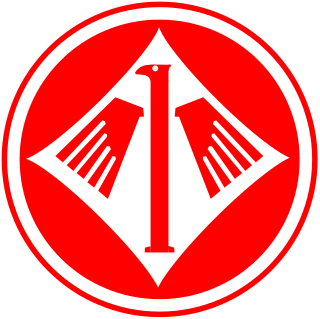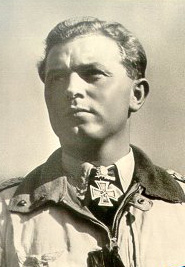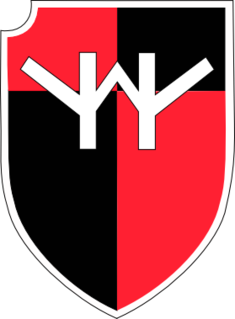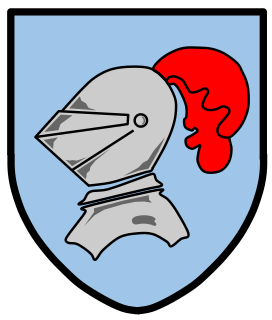Related Research Articles

Operation Bodenplatte (Baseplate), launched on 1 January 1945, was an attempt by the Luftwaffe to cripple Allied air forces in the Low Countries during the Second World War. The goal of Bodenplatte was to gain air superiority during the stagnant stage of the Battle of the Bulge so that the German Army and Waffen-SS forces could resume their advance. The operation was planned for 16 December 1944, but was delayed repeatedly due to bad weather until New Year's Day, the first day that happened to be suitable.

Heinz "Pritzl" Bär was a German Luftwaffe flying ace who served throughout World War II in Europe. Bär flew more than one thousand combat missions, and fought in the Western, Eastern and Mediterranean theatres. On 18 occasions he survived being shot down, and according to records in the German Federal Archives, he claimed to have shot down 228 enemy aircraft and was credited with 208 aerial victories, 16 of which were in a Messerschmitt Me 262 jet fighter.

Jagdgeschwader 1 (JG 1) "Oesau" was a German World War II fighter wing created in 1939. Between 1940 and 1942, JG 1 operated primarily over the Western Front and northern occupied Europe. During the initial days of the war, JG 1 faced little resistance, apart from occasional Royal Air Force (RAF) excursions. The unit was rarely engaged in large-scale confrontations during this time.

Jagdgeschwader 2 (JG 2) "Richthofen" was a German fighter wing during World War II. JG 2 operated the Messerschmitt Bf 109 and Focke-Wulf Fw 190 single-seat, single-engine Interceptor aircraft.

Walter "Gulle" Oesau was a German fighter pilot during World War II. A fighter ace, he served in the Luftwaffe from 1934 until his death in 1944. He rose to command Jagdgeschwader 1, which was named in his honor after his death.

Siegfried Freytag was a World War II German Luftwaffe pilot and wing commander. As a fighter ace, he was credited with 102 aerial victories of which 49 victories were claimed over the Eastern Front. Among his victories over the Western Front are at least 2 four-engine bombers. He was a recipient of the Knight's Cross of the Iron Cross Freytag had been nominated for the Knight's Cross of the Iron Cross with Oak Leaves, but the war ended before the paperwork had been processed.

Gustav Rödel was a German fighter pilot and fighter ace who served during World War II in the Luftwaffe.

Jagdgeschwader 6 Horst Wessel was a Luftwaffe fighter wing during World War II. Created late in the war as one of the last Jagdgeschwader, JG 6 fought on the Western and Eastern Fronts and in the Defence of the Reich over Germany. This period of the air war was characterised by few successes and heavy losses among the German fighter arm.

Jagdgeschwader 4 was a Luftwaffe fighter-wing of World War II.
Gerhard Vogt was a German Luftwaffe military aviator and fighter ace during World War II. He is credited with 48 aerial victories, claimed over the Western Front and in Defense of the Reich in 174 combat missions.

Günther Specht was a German Luftwaffe fighter ace during World War II.

Nachtjagdgeschwader 3 was a Luftwaffe night fighter-wing of World War II. NJG 3 was formed on 29 September 1941 in Stade from Stab./Zerstörergeschwader 26.
In aerial warfare, the term overclaiming describes a combatant that claims the destruction of more enemy aircraft than actually achieved. The net effect is that the actual losses and claimed victories are unequal.
During the Second World War the German Luftwaffe was the main support weapon of the German Army (Heer). It fought and supported the Wehrmacht's war effort throughout the six years of conflict and contributed to much of Nazi Germany's early successes in 1939–1942. After the turn in Germany's fortunes, it continued to support the German ground forces until the German surrender in May 1945.
Nachtjagdgeschwader 5 was a Luftwaffe night fighter-wing of World War II. NJG 5 was formed on 30 September 1942 in Döberitz.
Karl Borris was a World War II Luftwaffe military aviator and test pilot. As a flying ace, he is credited with 43 victories, all of them over the Western Front, for which he was awarded the Knight's Cross of the Iron Cross, the highest award in the military and paramilitary forces of Nazi Germany during World War II. Borris was involved in the introduction of the Focke-Wulf Fw 190 to front line service. Borris and 30 other pilots, technicians and engineers extensively tested the Fw 190 and their input was used in the decision to continue the project.
Operation Bodenplatte, launched on 1 January 1945, was an attempt by the Luftwaffe to cripple Allied air forces in the Low Countries during the Second World War. The Germans husbanded their resources in the preceding months at the expense of the units defending against the Allied strategic bombing in what was a last-ditch effort to keep up the momentum of the German Army (Heer) during the stagnant stage of the Battle of the Bulge.
Hermann Staiger was a Luftwaffe ace and recipient of the Knight's Cross of the Iron Cross during World War II. The Knight's Cross of the Iron Cross was awarded to recognise extreme battlefield bravery or successful military leadership. For the fighter-pilots it was a quantifiable measure of their skill and success. Hermann Staiger was credited with 63 aerial victories during World War II, 49 on the Western Front and 14 on the Eastern Front.
Hans Dortenmann was a German Luftwaffe military aviator and fighter ace during World War II. He is credited with 39 aerial victories achieved in 150 combat missions. This figure includes 17 aerial victories on the Eastern Front and 22 over the Western Allies.
Waldemar Radener was a German Luftwaffe military aviator and fighter ace during World War II. He is credited with 37 aerial victories, all of which claimed over the Western Front and in Defense of the Reich.
References
Citations
- ↑ Girbig 1975, p. 75.
- ↑ Manrho & Pütz 2004, pp. 288-289.
Bibliography
- Bekker, Cajus. Angriffshöhe 4000. ISBN 3-453-87098-0
- Caldwell, Don.JG 26; Top Guns of the Luftwaffe. New York: Ballantine Books, 1991. ISBN 0-8041-1050-6
- Caldwell, Donald L. (1994). JG 26 Photographic History of the Luftwaffe's Top Gun. Motorbooks International Publishers & Wholesalers. ISBN 0-87938-845-5.
- Caldwell, Donald L.; Muller, Richard R. (2007). The Luftwaffe over Germany: Defense of the Reich. London, UK: Greenhill Books. ISBN 978-1-85367-712-0.CS1 maint: discouraged parameter (link)
- Cooper, Mathew (1981), The German Air Force 1933-1945: An Anatomy of Failure, New York: Jane's Publishing Incorporated, ISBN 0-531-03733-9
- Cox and Gray, Sebastian and Peter (2002). Air Power History: Turning Points from Kitty Hawk to Kosovo. Frank Cass. ISBN 0-7146-8257-8
- de Zeng, H.L; Stanket, D.G; Creek, E.J. Bomber Units of the Luftwaffe 1933-1945; A Reference Source, Volume 1. Ian Allan Publishing, 2007. ISBN 978-1-85780-279-5
- de Zeng, H.L; Stanket, D.G; Creek, E.J. Bomber Units of the Luftwaffe 1933-1945; A Reference Source, Volume 2. Ian Allan Publishing, 2007. ISBN 978-1-903223-87-1
- Forsythe, Robert. JV 44; The Galland Circus. Burgess Hill, West Sussex, UK: Classic Publications, 1996. ISBN 0-9526867-0-8
- Forsythe, Robert & Laurier, Jagdverband 44: Squadron of Experten. Osprey. London. 2008. ISBN 978-1-84603-294-3
- Franks, Norman The Battle of the Airfields: 1 January 1945. Grub Street. 1994. London. ISBN 0-7183-0448-9 & ISBN 1-902304-42-X
- Franks, Norman Fighter Command Losses of the Second World War: Volume 3, Operational Losses, Aircraft and Crews 1944-1945. (Incorporating Air Defence Great Britain and 2nd TAF Midland. 2000. London. ISBN 1-85780-093-1
- Girbig, Werner (1975), Six Months to Oblivion: Defeat of the Luftwaffe Fighter Force Over the Western Front, 1944/45, New York: Hippocrene Books, ISBN 978-0-88254-360-4 .
- Girbig, Werner (1989), Start im Morgengrauen, Germany: Pietsch-Verlag Paul Pietsch Verlage GmbH + Co, ISBN 3-613-01292-8 .
- Girbig, Werner (2007), Six Months to Oblivion: Defeat of the Luftwaffe Fighter Force Over the Western Front, 1944/45, Schiffer Publishing, ISBN 978-0-88740-348-4 .
- Hall, Cargill (1998), Case Studies In Strategic Bombardment, Air Force History and Museums Program, ISBN 0-16-049781-7 .
- Johnson, J.E. Wing Leader (Fighter Pilots). London: Goodall Publications Ltd. 2000 (original edition 1956). ISBN 0-907579-87-6.
- Manrho, John; Pütz, Ron (2004), Bodenplatte: The Luftwaffe's Last Hope-The Attack on Allied Airfields, New Year's Day 1945, Ottringham, United Kingdom: Hikoki Publications, ISBN 1-902109-40-6 .
- National Archives. (2000) The Rise and Fall of the German Air Force, 1933-1945. ISBN 978-1-905615-30-8
- Peszke, Michael Alfred (October 1980). "A Synopsis of Polish-Allied Military Agreements During World War Two". Military Affairs. 44 (3): 128–134. doi:10.2307/1987437.
- Prien, Jochen & Stemmer, Gerhard. Jagdgeschwader 3 "Udet" in World War II. Atlgen, Germany: Schiffer Military History, 2002. ISBN 0-7643-1681-8
- Schramm, Percy E., ed. (1982). Kriegstagebuch des Oberkommandos der Wehrmacht: 1944-1945 Teilband II (revised ed.). München: Bernard & Graefe Verlag. ISBN 3-88199-073-9.
- Weal, John. Jagdgeschwader 27 'Afrika'. Osprey, London. 2003. ISBN 1-84176-538-4
- Weal, John. Focke-Wulf Fw 190 Aces of the Western Front. Osprey, London. 1996. ISBN 978-1-85532-595-1
- Weal, John. Bf 109 Defence of the Reich Aces. Osprey, London. 2006. ISBN 1-84176-879-0
- Weinberg, Gerhard. A World At Arms, Cambridge University Press: 2 edition, 2005, ISBN 978-0-521-61826-7
- Zaloga, Steven J., Gerrard, Howard. Battle of the Bulge (2). London: Osprey Publishing, 2004. ISBN 1-84176-810-3